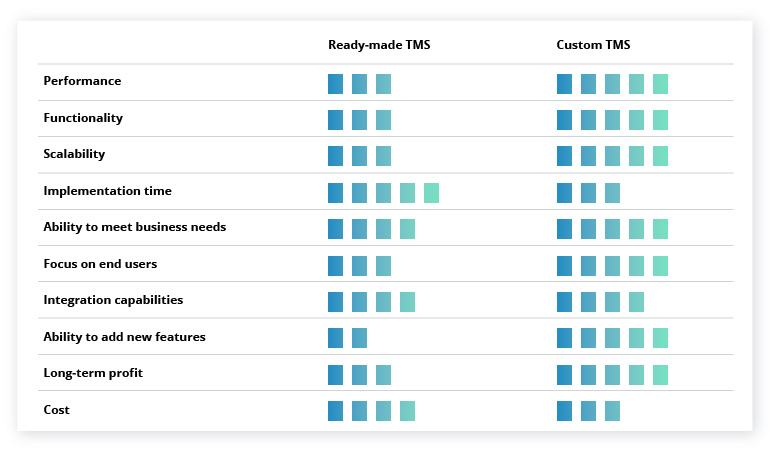As a supply chain or logistics professional, you want to ensure your stakeholders are satisfied, from suppliers to consumers. Overwhelming data, manual processes, and expensive mistakes are gradually becoming a thing of the past and less often impacting supply chains as more and more organizations implement transportation management software.
Transportation management system (TMS) software makes it possible to track the entire supply chain. It enables you to capture reliable and structured data from the moment you create or source your product to the moment it’s delivered to your end customer.
Every logistics company, no matter the size, can benefit from transportation management software by improving operational product management processes, reducing delivery costs, preventing time and money losses, increasing supply chain visibility, and getting more accurate insights to make informed decisions.
What is a TMS and how does it work? If you decide to implement a TMS in your organization, what options do you have? Let’s talk about it.
What transportation management software is and how it works within a company
A TMS is a platform that gathers, organizes, and processes all shipment-related data — from inbound and outbound logistics information to all your carrier activity — in one place. It’s software that allows manufacturers, suppliers, distributors, and 3PL/4PL providers to plan, execute, and optimize logistics processes throughout the supply chain.
Logistics management software can cover not only movable goods and shipments but all kinds of equipment management, asset management, business process optimization, and so on. It’s also helpful in planning operations and stock levels, as it provides essential data insights for detecting possible issues in business processes and the supply of products early on.
Important features of transportation management system software are:
- Comprehensive route planning
- Fleet management optimization
- Multimodal shipping of cross-border and domestic freight
- Calculation of transportation costs
- Management of contracts for customers and carriers
- Support and coverage of the complete transportation lifecycle
Benefits you can get from TMS software:
- Collection of data from multiple sources (purchase orders and general ledger information, carrier information, data from IoT sensors, GPS tracking data, etc.)
- Automation of business processes (connecting customers with carriers, applying for optimal freight orders, etc.)
- Generation of valuable insights using data analytics capabilities (reporting on operation performance, finances, customer satisfaction, etc.)
Without logistics management software, the only way to look for an available carrier is manually. This involves making calls, negotiating rates, and tracking the entire shipment process manually. With a TMS in place, shippers can connect with carriers automatically. A fleet tracking system will send information about available trucks to all your customers, compare rates by connecting to the freight marketplace, and book the most favorable deals automatically.
As a shipment moves further, it’s possible to track the delivery process until the product gets to the customer. Plus, if you analyze historical data using proper AI algorithms, you’ll be able to better optimize shipment routes and plan fleet capacity.
A TMS can be integrated with other software, such as an enterprise resource planning (ERP) system or warehouse management system (WMS), to provide even more accurate information and support end-to-end delivery more effectively.
Such logistics management solutions can improve nearly every part of the shipment process. Greater transparency and visibility facilitate more efficient planning and execution, whereas AI-generated insights allow for optimizing future processes, therefore increasing customer satisfaction and helping shippers grow their businesses. In other words, by implementing a TMS today, you are guaranteed to benefit tomorrow.
A closer look at the transportation management workflow
The entire transportation management workflow can be divided into three phases: planning, execution, and optimization. Let’s take a look at each.
Planning
A transportation management software system can help you select the optimal route, best carrier, and most cost-effective method of delivery. TMS solutions provide your business with greater visibility into every stage of the supply chain. You can further enhance this visibility with data about order rates, not to mention customs delays and trade regulations.
Execution
A TMS solution can help logistics companies match loads, communicate with carriers on the scale of delivery, and track shipments and documents in real time. Moreover, transportation management systems are superb at handling international shipments, as logistics management software can provide required documentation for customs, including permits, trade compliance certificates, and other important paperwork.
Optimization
All logistics operations have associated data. Transportation management software can use this data to track the performance of your supply chain. A TMS can provide insights about future shipments, deliver transportation intelligence through IoT devices, and see whether there are any hiccups in the process.
How TMS solutions work within a supply chain

Challenges transportation management software solves
By design, TMS solutions are great at providing supply chain visibility, but there’s more than meets the eye. Transportation management systems are made to provide full control of your entire supply chain. Through various features, every division within your logistics business can solve various problems. Here are some of the TMS features you can take advantage of.
Freight analysis
TMS solutions can be used to plan and inbound and outbound product movements. Learn how much it would cost you and what performance your freight partners can provide.
Manufacturing scheduling
Scheduling doesn’t have to be difficult. Transportation management software can give you a reliable estimate as to how much inbound material is required for the manufacturing schedule.
Distribution visibility
Supply chain transparency is one of the most critical challenges for every shipper. Logistics management solutions like TMSs provide greater visibility of inbound material requirements needed to fill shipment orders. At the next stage of digital innovation in supply chains, digital twins in logistics may make the entire supply chain visible.
Procurement reports
Reports are hard to obtain when a chunk of operations are done manually. A TMS can help you manage vendor supply performance and gain access to detailed reports at scale if you are working with multiple suppliers.
Financial audits
From basic invoicing to freight audits to payment schedules, logistics management software can help your financial department process more transactions as well as analyze cost efficiency.
Order tracking
Through various software-powered electronic logging device (ELD) sensors installed on trucks, roads, and distribution centers, logistics management solutions can gather data and track customer orders as well as provide frequent updates.
Customer service
Transportation management software can be used to provide customer support. Moreover, a TMS can deliver updates as to where parcels are and when they will be available.
The best part is that by building a new custom platform, you can integrate functions found in your TMS into your current ERP system using EDI or API calls. With added TMS software, taking control of the supply chain becomes significantly easier.
What features should a sophisticated TMS offer its users?
Most transportation management solutions are powered with a set of features needed to deal with the challenges outlined above. However, when a business is determined to implement a game-changing solution, considering more sophisticated software may be necessary. Let’s look at the key features that are worthwhile when choosing custom TMS software development.
Automated price calculations
The final delivery price is impacted by many factors. Some of them change often, while others are more or less stable. For example, fuel costs may change a few times per week, while a driver’s salary is relatively more stable and might be reviewed once every six months.
Besides fuel costs and personnel salaries, other factors impacting the price of delivery include vehicle maintenance costs, fixed margins, and administrative fees. And if you want the TMS to calculate the total delivery price accurately and in a timely manner, it should be supplemented with an automated pricing engine that updates calculations every time a factor changes.
Smart load management
Load management is one of the most resource-consuming processes at almost any large transportation and logistics company. But let’s look at it differently: complexity makes load management a perfect domain for optimization.
Sophisticated transportation system development powered with smart load management features enable businesses to build optimized loads by entering, tracking, and filtering key parameters such as warehouse, order type, delivery date, route, and product group in a single interface.
Using smart load management functionality, users can also change a warehouse’s or truck’s status in a few clicks by assigning goods to a relevant track or warehouse section.
Advanced route planning
Most transportation management software developers provide basic route planning functionality. Yet if you’re looking for a one-of-a-kind TMS, it must offer something more than mileage and fuel calculations.
Advanced route planning features provide users with vehicle suggestions based not only on proximity to a particular object but also on characteristics of both the vehicle and the load. For example, if you need to deliver fresh meat, an advanced route planning system can save you from having to manually search for and select refrigerated vehicles. The system can do it for you.
Shipment tracking
Today, transportation management software developers enable businesses to identify potential shipment-related issues in advance and proactively respond to them. That both prevents unexpected delivery cost increases and saves customers’ money.
Such solutions can be connected to offline communication tools so drivers or operators can report potential issues even if a GPS signal or internet connection is lost.
Imagine a truck driver arriving at a delivery point that is suddenly closed for whatever reason. If advanced shipment tracking functionality is used, the problem would be reported immediately, enabling a logistics manager to suggest the best solution to the driver, be it skipping the delivery or changing the delivery point.
Flexibility and multiple integration options
If you’re not new to the transportation and logistics business, you don’t need an explanation of how many systems can be used by a business for various purposes and how important it is to ensure their integrity and coherence.
If you’re going to use a custom TMS software development solution in combination with a CRM, warehouse administration system, human resources system, or accounting software, make sure the TMS you’ve chosen supports smooth integration.
Advanced modules to improve your TMS
As your business grows, your logistics and transportation management application must also become more complex. At some point, a TMS with conventional or even advanced functionality may turn out to be insufficient. And that’s where advanced modules come in handy.
Distributed order management module
A distributed order management module would be the most relevant for companies working with omnichannel logistics structures.
If you’re going to scale up supply chain operations to several storefronts and warehouses or if you have already done so, be prepared that traditional transportation management system development might not bring the expected value. Instead, consider adding a distributed order management module to your TMS.
Here are the advantages of using such modules:
- Orders received from multiple channels are integrated into a single ecosystem
- Multiple ERP and order management systems can be managed in a coherent and aligned way
- Each order status is updated live in a single dashboard
- Automatic system updates are supported, i.e. if any external or internal factor changes, such as route time or fuel price, the status of current and related deliveries is updated automatically
- Code infrastructure management for complex requests, e.g. the ability to control the temperature inside a vehicle
Management by exception module
Management by exception modules enhance regular automation capabilities. Most conventional transportation management solutions provide integrated automation features. In practice, this means that a manager can automate either all processes and orders or, vice versa, manage all of them manually.
In contrast, management by exception implies that regular orders are processed automatically. If a particular unexpected event occurs and it impacts the order processing, the system notifies a manager so they can make corresponding corrections or reassign the process.
This kind of smart automation module would be relevant primarily for businesses managing hundreds and thousands of orders per week. Management by exception enables managers to save time, which is often spent on manually double-checking processed orders.
With real-time notifications sent by a smart automation module, businesses can proactively respond to changes. Custom TMS software development solutions also allow for setting up automated workflows for every type of unexpected event that may occur. If you’re eager to minimize human involvement in logistics management by any means, this feature is what you need from your development office.
How logistics management software can increase supply chain visibility
The primary objective of logistics management solutions is to make data available, process it, and deliver it directly to customers and other stakeholders. This data availability, along with data accuracy, is critical to the functionality of a TMS.
Transportation management software ensures data delivery using various methods, chief among them being IoT devices such as GPS trackers, RFID, and supplementary software. Over the past 5 to 10 years, commercially available, non-enthusiast camera technology has become not just affordable but powerful enough to deliver tangible data through video telematics.
Another data source logistics management software can feed on is delivered through carriers. Suppliers, forwarders, brokers, and even 3PL companies possess valuable information your business can use. Combine the data received from these entities with data in your warehouse management system and enterprise resource planning system and you can expect to solve your logistics problems more efficiently.
Big data technology, predictive algorithms, and smart container tracking can be stitched together to improve the effectiveness of TMS software. This union will allow you to achieve ubiquitous supply chain visibility.
Logistics management solutions: What options do you have?
Business owners can pick from several options for obtaining logistics management software. They can purchase a ready-made solution or develop a custom solution tailored to their individual requirements.

Implementing ready-made software has both strengths and limitations depending on your needs. On-premises TMS solutions, for example, are run locally on your server hardware. They are super secure and functional, but they’re not optimal for every business due to complex hardware maintenance.
Cloud-based transportation management system software is considered the most accessible, as you don’t need powerful hardware to run it, nor do you need to configure it. It’s also very scalable. However, you may not be impressed with the available functionality of some cloud-based logistics services.
A custom platform can be adapted to your business needs better than anything else. Although more expensive up front, custom logistics management solutions are financially more reasonable in the long run. Not only will you have full control over the solution; you also won’t have to pay a monthly fee to the vendor.
New technologies and transportation management software trends to keep tabs on
More and more logistics companies are adopting innovative logistics solutions such as TMSs in their supply chains. The benefits are hard to ignore, and the barrier to entry is low compared to other technological solutions.
Cloud-based enhancements
As technology advances, TMS tools will not only become more accessible but more potent in what they can do. In times of rapidly changing customer demand, transportation management system software allows suppliers to react to fluctuations rapidly, helping them save money.
Automation of management processes
Today, more and more transportation management software solutions are shifting their focus towards automation of critical shipment processes. From dock scheduling to load execution to tendering and freight settlement, a TMS helps create a more autonomous package journey.
User-oriented interface
More transportation management software developers are focusing on the user experience. No amount of automation can eliminate the human factor; therefore, delivering an accessible and responsive user experience is becoming more important.
TMS software: The first thing you need to increase supply chain visibility
Having a TMS solution in your supply chain is not only about streamlining your logistics operations but also about remaining competitive. More and more companies, both big and small, are investing in TMS software, as it helps them manage more work with fewer resources.
Whether you wish to tackle fleet management, order batching, or any other logistics challenge, TMS software is the way to go. If your business is struggling to meet ever-changing customer demands or has trouble with batching and document processing, logistics management software is your best option.
Looking for ways to develop a custom transportation management system with our experts? Let’s talk about it! The Intellias team is here to consult with you about possible technological solutions.




